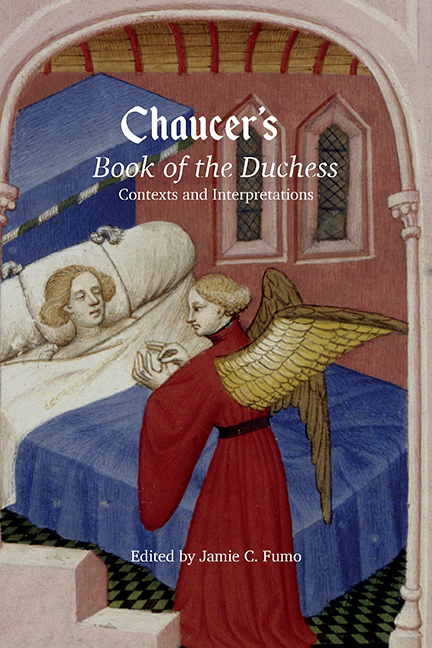Book contents
- Frontmatter
- Contents
- List of Illustrations
- Acknowledgments
- List of Contributors
- Abbreviations and Editions
- Introduction: Reopening the Book of the Duchess
- I Books and Bodies
- II The Intertextual Duchess
- 5 Alcyone's Grave: Inscription and Intertextuality in Chaucer, Spenser, and Ovid
- 6 Tribute to a Duchess: The Book of the Duchess and Machaut's Remede de Fortune
- 7 ‘Hyt am I’: Voicing Selves in the Book of the Duchess, the Roman de la rose, and the Fonteinne Amoureuse
- 8 ‘Counterfeit’ Imitatio: Understanding the Poet-Patron Relationship in Machaut's Fonteinne amoureuse and Chaucer's Book of the Duchess
- 9 The Shock of the Old? The Unsettling Art of Chaucer's Antique Citations
- 10 Response: The Book of the Duchess, Guillaume de Machaut, and the Image of the Archive
- Bibliography
- Index
- Miscellaneous Endmatter
7 - ‘Hyt am I’: Voicing Selves in the Book of the Duchess, the Roman de la rose, and the Fonteinne Amoureuse
from II - The Intertextual Duchess
Published online by Cambridge University Press: 18 April 2018
- Frontmatter
- Contents
- List of Illustrations
- Acknowledgments
- List of Contributors
- Abbreviations and Editions
- Introduction: Reopening the Book of the Duchess
- I Books and Bodies
- II The Intertextual Duchess
- 5 Alcyone's Grave: Inscription and Intertextuality in Chaucer, Spenser, and Ovid
- 6 Tribute to a Duchess: The Book of the Duchess and Machaut's Remede de Fortune
- 7 ‘Hyt am I’: Voicing Selves in the Book of the Duchess, the Roman de la rose, and the Fonteinne Amoureuse
- 8 ‘Counterfeit’ Imitatio: Understanding the Poet-Patron Relationship in Machaut's Fonteinne amoureuse and Chaucer's Book of the Duchess
- 9 The Shock of the Old? The Unsettling Art of Chaucer's Antique Citations
- 10 Response: The Book of the Duchess, Guillaume de Machaut, and the Image of the Archive
- Bibliography
- Index
- Miscellaneous Endmatter
Summary
In his account of the story of Ceyx and Alcyone, the narrator of the Book of the Duchess describes how Juno sends a messenger to the god of sleep. In the versions of this story with which Chaucer was familiar, the messenger is identified as the goddess Iris, but in Chaucer's telling he becomes male and is given no name. The messenger finds the slumbering bodies of the god and his company lying in the dark cave in which they live, and he rouses them by blowing his horn and crying, ‘Awaketh!’ (BD 183). Morpheus, displeased, opens one eye to ask, ‘Who clepeth ther?’ (185). Before going on to relate Juno's orders, the messenger responds with three simple words of self-identification:
‘Hyt am I’, quod this messager. (186)
In this brief scene of recognition, the messenger's voice, or his presence before Morpheus as an embodied voice, is enough to transmit unproblematically some sense of his identity, even as Chaucer deliberately suppresses the proper name that might help his readers anchor their understanding of who this figure might be. The scene encapsulates, I believe, one of the central concerns of the Book of the Duchess: What is the relationship between a thing spoken and the one who speaks it? Represented in a ‘book’ – the ‘book’ of the Duchess – this concern expands to embrace something yet more fundamental to the work itself: What is the relationship between a thing written and the one who writes it? The sense that linguistic self-referentiality might be enough to guarantee the link between voice and self (and the troubling and necessary implication that it might not be) finds an echo in the narrator's only attempt at self-identification: ‘I, that made this book’ (96). In a work in which Chaucer explores his position in relation to a known extra-textual figure, John of Gaunt, the question of how one should speak for oneself becomes particularly urgent, even if the answer remains oddly elusive.
- Type
- Chapter
- Information
- Chaucer's Book of the Duchess , pp. 135 - 156Publisher: Boydell & BrewerPrint publication year: 2018

